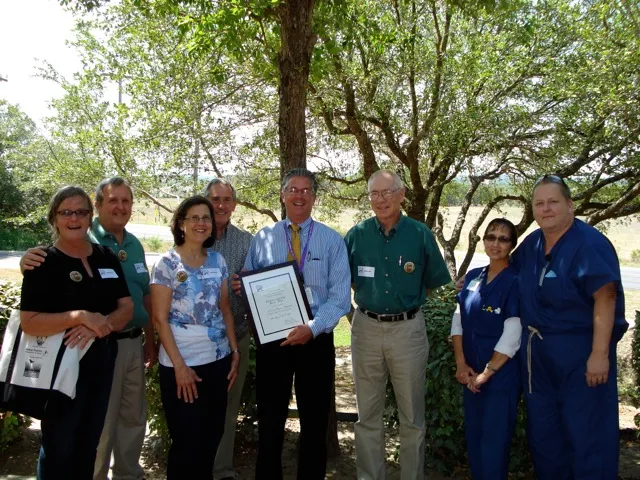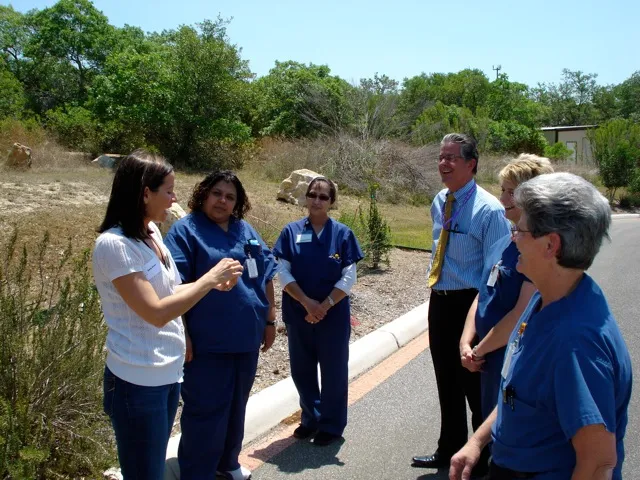By Delmar Cain
It would be a rare individual who does not have some appreciation for this area of Texas that we call the Hill Country. I am sure that such an individual exists but I have never met him personally. The rest of us seldom tire of letting others know where we live and how fortunate we consider ourselves for being here.

But what is it about the Hill Country exactly that is so attractive? A survey would probably provide many reasons, but high on my list is the pure unadulterated beauty that I see each time I look or go outside. To me that beauty is not singular but the whole package — a combination of limestone rocks, hills, clear creeks, green trees, and flowering shrubs, wildflowers and vines.
But I am not the only one who appreciates the beauty of the Hill Country. So do varied species of birds, butterflies and bats that live here or return in abundant numbers each year. And so does Bill Pippen, president of Stanbio Laboratory, who has demonstrated his appreciation in a very substantial way. He tried to save as much as he could of the native natural beauty of the site when he built the plant facilities. That is why on April 29, 2011, the Boerne Chapter of the Native Plant Society of Texas (NPSOT) awarded its first Nonresidential Landscape Recognition Award to Stanbio Laboratory and its president, Bill Pippen. Al Blanco, vice-president for marketing, accepted the award.
When he moved his company here to Boerne from San Antonio in 2001, Bill Pippen made sure that he kept the native beauty of his property so that he could see it each time he came to work and when he left. He saved it again when he expanded his company at its North Main location. This is what you see if you tour the grounds.

It is not just parking spaces that the visitors and employees see when they arrive. They see places to park among islands where native trees larger than 2 inches in diameter were preserved and other desirable trees were added. In the islands and the landscaped area around the building are live oak trees, Spanish oak, hackberry, mountain laurel, big tooth maples, burr oak, flameleaf sumac, Monterey oak and Texas persimmon.
The variety and diversity insures that under ordinary conditions the grounds will not go treeless.
Laid out in eye-pleasing designs under the trees are, among other plants, twist leaf yucca, turk’s cap, pink pavonia, cenizo, dewberry, autumn sage, lantana, Lindheimer muhly and greenbriar. The walkway into the building passes over clear running water moving over rocks like an ever-flowing Hill Country spring. The water is recycled from plant operations and air-conditioning condensate.
Areas beyond the parking lots were left natural also. There the birds and butterflies can find Virginia creeper, pearl milkweed vine, prickly pear, prickly ash, agarita, greenthread, evergreen sumac, fragrant sumac and the state grass of Texas, sideoats grama. The slope of the grounds and the large rocks that were left in place show a love of the Hill Country. The natural area also creates a handsome barrier to allow the adjoining neighbors to feel they are still in a rural area.
This kind of care and attention for the native beauty is a wonderful concrete example of the stated goals of the Native Plant Society of Texas. In designing for, constructing around, keeping and adding to the native greenery around the site, Bill Pippen showed an “understanding of and an enjoyment of the native flora of Texas”. In preserving the trees and flowers he is now promoting the native beauty to all who will look. I say that he put his money where our NPSOT mouths are. But when asked he said it better — “I love the Hill Country and I want to keep it and pass it on.”
Stanbio Laboratory, through Bill Pippen, is doing its part to help preserve this special area that we call the Hill Country. It joins others like the Cibolo Nature Center, the Lende Trust, and the Kendall County Partnership for Parks in making sure that the next generation will be able to enjoy at least a part of what an early Texas ranger referred to as “an earthly paradise.”


